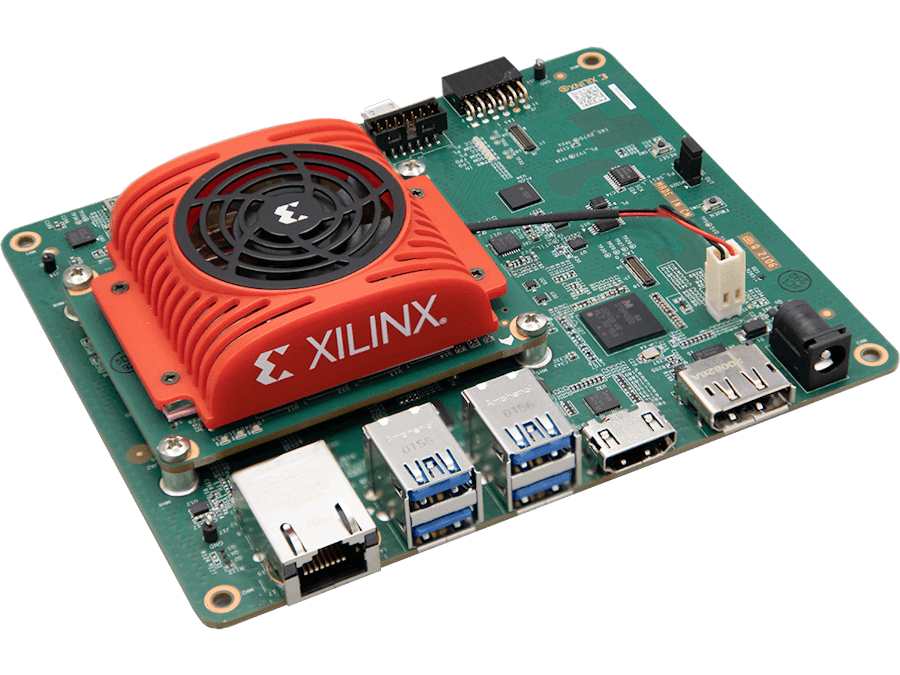This guide will help you get familiar with and start using the Xilinx Kria KV260. Check out the Xilinx Adaptive Computing Challenge featuring this board!
Resources- Kria App-Store:https://www.xilinx.com/products/app-store/kria.html
- Video:https://www.xilinx.com/video/som/out-of-the-box-with-kria-kv260-up-and-running-in-under-an-hour.html
- Getting Started Guide:https://www.xilinx.com/products/som/kria/kv260-vision-starter-kit/kv260-getting-started/getting-started.html
The Xilinx® Kria KV260 Vision AI Starter Kit is the premier platform to evaluate your Vision AI-based applications; it is comprised of a non-production version [JSK1] of the K26 system-on-module (SOM), carrier card, and thermal solution. The SOM is very compact and only includes key components such as a Zynq® UltraScale+™ MPSoC based silicon device, memory, boot, and security module. The carrier card allows various interfacing options and includes a power solution and network connectors for thecamera, display, and microSD cards. The thermal solution has a heat sink, heat sink cover, and fan. The Kria KV260 Vision AI Starter Kit is designed to provide customers a platform to evaluate their target applications and ultimately design their own carrier card with Xilinx K26 SOMs.
For more detailed specifications of the Kria KV260 Vision AI Starter, please refer to:
· DS986 – Datasheet
· UG1091 – User Guide
While the SOM itself has broad AI/ML applicability across markets and applications, target applications for the Kria KV260 Vision AI Starter Kit include smart city and machine vision, security cameras, retail analytics, and other industrial applications.
Accelerated Applications:
With the Kria™ KV260 Vision AI Starter Kit, Xilinx proudly introduced users to the concept of accelerated applications. These are pre-built applications for AI and SW developers, giving them a head start to develop their target end-applications. Explore Kria App store for more details.
Utilities:
The KV260 Starter Kit is unique in its ability to load and run applications that configure the hardware to implement a variety of functions. The utility “xmutil” is used to load the various applications. One accelerated application can be loaded at a given time.
Getting StartedFor a quick overview of the unboxing and bring-up experience with the KV260 Starter Kit, please watch the video: https://www.xilinx.com/video/som/getting-started-kria-som-vision-ai-starter-kit.html
Step 1: microSD card setup.
Download the 2021.1- https://www.xilinx.com/support/download/index.html/content/xilinx/en/downloadNav/embedded-design-tools/2021-1.html
(WIC Image Update 1), and flash that image onto your SD card. Depending on your Operating System, choose a SD card flashing tool. We recommend BalenaEtcher for handling the SD card flash process
Step 2: Connecting the board.
Insert the microSD in the slot on the board and start plugging in the following into the system: USB-A to microUSB cable that supports data transfer (micro-B connects to starter kit); IAS camera module; monitor/display (via DisplayPort or HDMI); and connect the power supply to the starter kit.
Step 3: Boot your starter Kit.
Directions vary depending on your Operating System
For Windows, use the Device Manager to observe which COM ports appear when you plug the USB cable attached to the KV260 Starter Kit into your computer. Ensure you have the FTDI virtual COM port driver installed and then configure your terminal program (e.g., TeraTerm, PuTTy) with the settings shown below.
· Baud rate = 115200
· Data bits = 8
· Stop bits = 1
· Flow control = None
· Parity = None
Power ON the Starter Kit by connecting the power supply to the AC plug. The power LEDs should illuminate, and a Linux UART response can be seen on the terminal program interface.
Step 4: Launch an accelerated application.
At this point you should be set up and ready to start developing!
For detailed instructions to get started and launch an accelerated application, refer to https://www.xilinx.com/products/som/kria/kv260-vision-starter-kit/kv260-getting-started/getting-started.html
Additional ResourcesGitHub:
You may find Xilinx free accelerated application source code.
- Smartcam:https://github.com/Xilinx/smartcam
- AIBox: https://github.com/Xilinx/aibox-reid
- Defect-Detect:https://github.com/Xilinx/defect-detect
Wiki Page:
Application Docs:
More Kria resources are available on this GitHub page (this includes general information, quick start guides, and tutorials among other documents).
Support Forums:
Xilinx Kria SOM Forum is also available for help troubleshooting, or any questions.
Training:
To learn more, enroll for the free training course and develop more in-depth understanding. The training course will help you learn about the Xilinx Kria™ System-on-Module (SOM) and Vision AI Starter Kit, enabling you to accelerate applications using the Vision AI Starter Kit right out of the box without any installation or FPGA knowledge.
Blogs and Articles:









Comments
Please log in or sign up to comment.